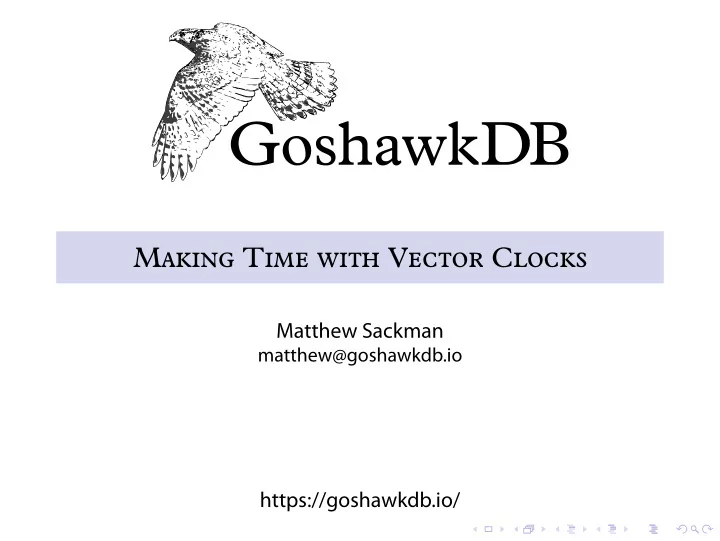

L • Strong serializability requires Consistency, so must sacrifice Availability • To achieve Consistency, only accept operations if connected to majority • If cluster size is 2 F + 1 then we can withstand no more than F failures
M V C I E T W
M V C I E T W
M V C I E T W
M V C I E T W
M V C I E T W
M V C I E T W
L • Strong serializability requires Consistency, so must sacrifice Availability • To achieve Consistency, only accept operations if connected to majority • If cluster size is 2 F + 1 then we can withstand no more than F failures • Writes must go to F + 1 nodes
R V C I E T W
R V C I E T W
R V C I E T W
R V C I E T W
R V C I E T W
R V C I E T W
L • Strong serializability requires Consistency, so must sacrifice Availability • To achieve Consistency, only accept operations if connected to majority • If cluster size is 2 F + 1 then we can withstand no more than F failures • Writes must go to F + 1 nodes • Reads must read from F + 1 nodes and be able to order results
T P D D 1. Client submits txn
T P D D 1. Client submits txn 2. Node(s) vote on txn
T P D D 1. Client submits txn 2. Node(s) vote on txn 3. Node(s) reach consensus on txn outcome
T P D D 1. Client submits txn 2. Node(s) vote on txn 3. Node(s) reach consensus on txn outcome 4. Client is informed of outcome
T P D D 1. Client submits txn 2. Node(s) vote on txn 3. Node(s) reach consensus on txn outcome 4. Client is informed of outcome Most important thing is all nodes agree on the order of transactions
T P D D 1. Client submits txn 2. Node(s) vote on txn 3. Node(s) reach consensus on txn outcome 4. Client is informed of outcome Most important thing is all nodes agree on the order of transactions (focus for the rest of this talk!)
L B O
L B O
L B O
L B O • Only leader votes on whether txn commits or aborts
L B O • Only leader votes on whether txn commits or aborts • Therefore leader must know everything
L B O • Only leader votes on whether txn commits or aborts • Therefore leader must know everything • If leader fails, a new leader will be elected from remaining nodes
L B O • Only leader votes on whether txn commits or aborts • Therefore leader must know everything • If leader fails, a new leader will be elected from remaining nodes • Therefore all nodes must know everything
L B O • Only leader votes on whether txn commits or aborts • Therefore leader must know everything • If leader fails, a new leader will be elected from remaining nodes • Therefore all nodes must know everything • Fine for small clusters, but scaling issues when clusters get big
C C B O
C C B O
C C B O
C C B O • Nodes receive txns and must vote on txn outcome and then consensus must be reached (not shown)
C C B O • Nodes receive txns and must vote on txn outcome and then consensus must be reached (not shown) • Clients are responsible for applying an increasing clock value to txns
C C B O • Nodes receive txns and must vote on txn outcome and then consensus must be reached (not shown) • Clients are responsible for applying an increasing clock value to txns • If a client’s clock races then it can prevent other clients from getting txns submitted
C C B O • Nodes receive txns and must vote on txn outcome and then consensus must be reached (not shown) • Clients are responsible for applying an increasing clock value to txns • If a client’s clock races then it can prevent other clients from getting txns submitted • So must be very careful to try and keep clocks running at the same rate
C C B O • Nodes receive txns and must vote on txn outcome and then consensus must be reached (not shown) • Clients are responsible for applying an increasing clock value to txns • If a client’s clock races then it can prevent other clients from getting txns submitted • So must be very careful to try and keep clocks running at the same rate • No possibility to reorder transactions at all to maximise commits
S V 1 < V 2 � ∀ x ∈ dom ( V 1 ∪ V 2 ) : V 1 [ x ] ≤ V 2 [ x ] ∧∃ y ∈ dom ( V 1 ∪ V 2 ) : V 1 [ y ] < V 2 [ y ]
S T
S T
S T
S T
S T
S T
S T
S T
T W
T W
Recommend
More recommend